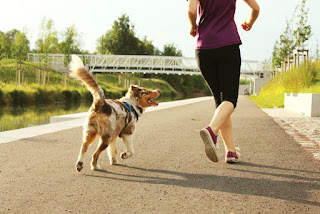Cesar Millan | Posted on
Exercising with your dog is a great way for the two of you to strengthen your bond and to get some cardiovascular in at the same time. While canine/human workouts can be fun, they can also be dangerous if proper safety precautions are not taken. Follow the tips below when working out with your dog to ensure that you both are safe:
1. Before exercising with your dog, make sure that he is physically fit enough to handle it.
Dogs should be evaluated by a veterinarian before starting a workout program. Also consider the dog’s age. Long distance workouts are not good for young and developing dogs and dogs that are too old may need to take it easy as well.
2. Do not just dive into an exercise routine.
Work your way into a more intensive workout regimen. Start slow and always warm up. Gradually build up your and your dog’s stamina before attempting long and hard workouts.
3. Consider your dog’s breed.
Some breeds are better equipped for harder exercise than others. Greyhounds, for example, do better with shorter sprints while pit bulls have a higher endurance and can tolerate longer distances.
4. Whether you are running, biking, hiking, walking, or rollerblading with your dog, make sure that he stays to one side of you the entire time.
It’s essential that you train your dog to stick to one side of you and not to dart in front while exercising beside you. This could cause you to trip, which can result in injury to both of you. Dogs that pull on the leash can cause damage to their throat and can also throw you off balance.
5. Consider environmental factors before you workout.
Running in the rain could be dangerous as it could cause you or your dog to slip and fall. During the summer, keep your workouts to early mornings or in the early evening, when the temperature is cooler. This will help you to avoid heat stroke, plus hot pavement can be uncomfortable on a dog’s feet. Avoid terrain that is uneven or rocky.
6. Stay hydrated. Carry water while exercising for lengthy periods.
This is especially crucial during warmer weather. If you have a long walk or hike planned, it can be a good idea to pack a few treats in order to keep your dog’s energy level up; you may even want to toss a granola bar in your backpack for yourself.
7. Don’t tie the leash to your wrist.
This could cause injury to you or your dog if he makes an unexpected jerk. Consider a hands-free leash for long distance walks or hikes. This is also convenient as it can also safely hold your keys, phone, and dog treats, making them easily accessible while you work out.
8. Use the proper safety equipment.
When biking or rollerblading with your dog, make sure to wear a helmet, kneepads, and other safety equipment. If you’re biking, it can be helpful to attach a Springer to your bicycle. This device fastens your dog’s leash to your bike and has a specially designed coil spring, which helps to absorb the force of a dog’s tug or lunge.
9. Don’t push it too hard.
Keep your eye on your dog. If he shows any signs of exhaustion, pain, soreness, excessive panting, or has trouble breathing, you’ve pushed it too far and it’s time to stop. Make sure to stop or slow down if you begin to feel tired or sore yourself. If you suspect you’ve overdone it, take a few days off from working out before engaging in additional exercise with your dog.
10. After the workout.
Check your dog’s feet for cuts, scrapes, or signs of worn down pads. If you worked out in a grassy or woodsy area, check his fur for burrs, ticks, and other foreign objects. Make sure to give your dog plenty of water to replenish fluids lost during the workout. Allow your dog to rest properly in between exercise routines.


No comments:
Post a Comment